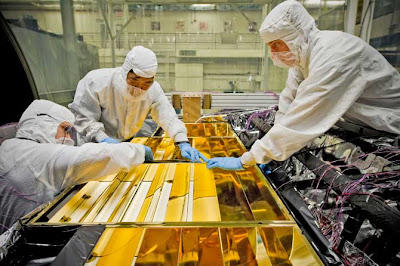Engineers Josh Lutter (on the right), Bruce Haines (center) and Scott Lam (on the left) tuck layers of blanketing in-between the gold-coloured louvers on the James Webb Space Telescope's Integrated Science Instrument Module (ISIM) Electronics Compartment (IEC) at NASA’s Goddard Space Flight Center in Greenbelt, Md.
The blanketing insulates and shields the flight instruments and the louvers will keep heat away from the temperature-sensitive instruments that will peer through dust clouds to see how stars form.
These engineers from Genesis Engineering Solutions are doing what’s called "blanket closeout" and it took two days to complete.
The gold louvers are composite mirrors, made of gold-coated carbon fiber, designed to remove the heat from inside the IEC to deep space.
The IEC holds computing hardware for each of the science instruments. This special part of the telescope allows the computer hardware to operate at room temperature on the cold side of the telescope by directing heat away so that the telescope can deliver infrared imagery.
"As heat radiates off the panel that they are attached to, the mirrors focus it in a particular direction (namely, away from the telescope)," says Lutter.
After the engineers completed blanketing, the IEC was then placed in the thermal chamber to be tested against the chill of a space-simulated environment. This process is called the thermal vacuum and balance test. During this test, temperatures drop to about 90 degrees Kelvin (-297.67 degrees Fahrenheit or -183.15 degrees Celsius).
"This is important because we need to know how effective the IEC is at keeping heat away from the cold side of Webb," says Lutter. "If even a little heat escapes the IEC in the direction of the telescope, the telescope's sensitivity could be ruined."
Related Link: NASA's James Webb Space Telescope
The blanketing insulates and shields the flight instruments and the louvers will keep heat away from the temperature-sensitive instruments that will peer through dust clouds to see how stars form.
These engineers from Genesis Engineering Solutions are doing what’s called "blanket closeout" and it took two days to complete.
The gold louvers are composite mirrors, made of gold-coated carbon fiber, designed to remove the heat from inside the IEC to deep space.
The IEC holds computing hardware for each of the science instruments. This special part of the telescope allows the computer hardware to operate at room temperature on the cold side of the telescope by directing heat away so that the telescope can deliver infrared imagery.
"As heat radiates off the panel that they are attached to, the mirrors focus it in a particular direction (namely, away from the telescope)," says Lutter.
After the engineers completed blanketing, the IEC was then placed in the thermal chamber to be tested against the chill of a space-simulated environment. This process is called the thermal vacuum and balance test. During this test, temperatures drop to about 90 degrees Kelvin (-297.67 degrees Fahrenheit or -183.15 degrees Celsius).
"This is important because we need to know how effective the IEC is at keeping heat away from the cold side of Webb," says Lutter. "If even a little heat escapes the IEC in the direction of the telescope, the telescope's sensitivity could be ruined."
Related Link: NASA's James Webb Space Telescope








No comments:
Post a Comment